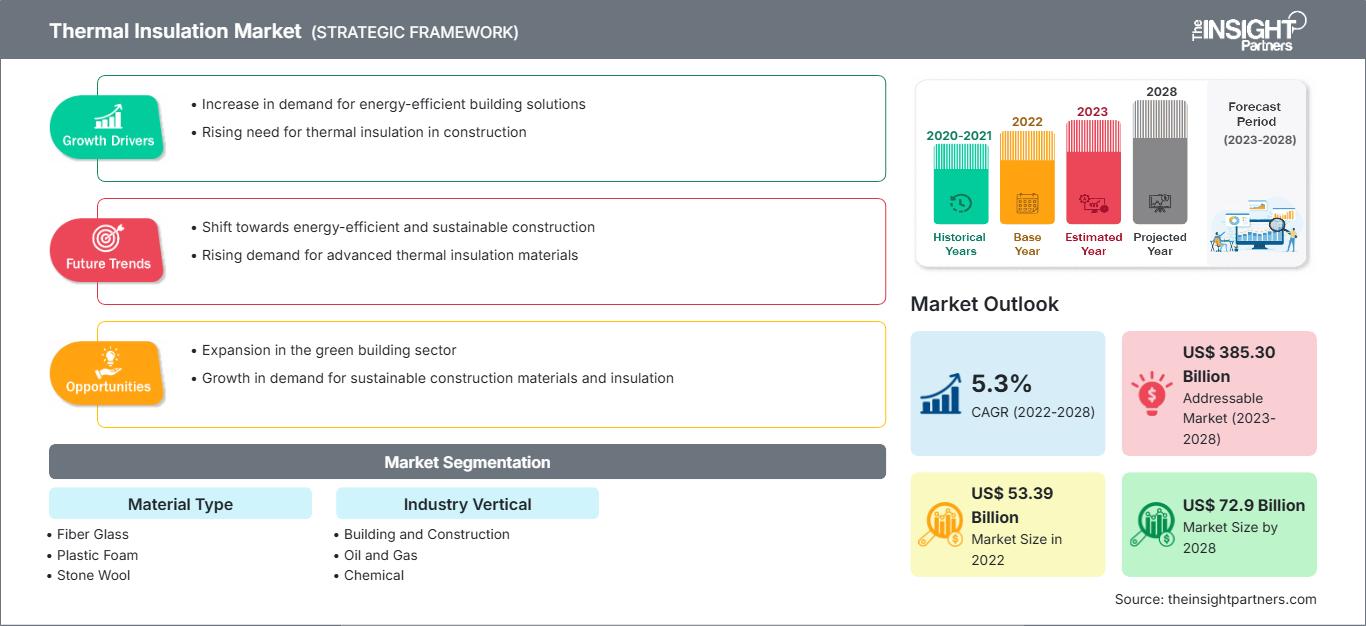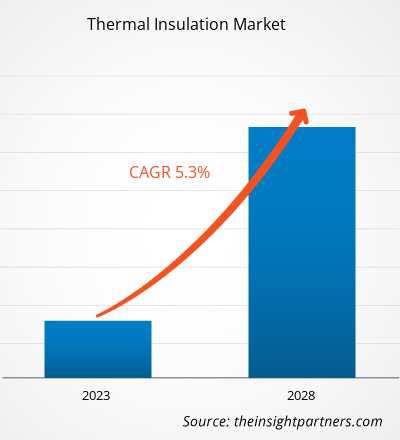Si prevede che il mercato dell'isolamento termico crescerà da 53,39 miliardi di dollari nel 2022 a 72,90 miliardi di dollari entro il 2028; si prevede una crescita a un CAGR del 5,3% dal 2022 al 2028.
La domanda di isolamento termico è aumentata grazie ai suoi vantaggi. Riduce i costi energetici e il trasferimento di calore tra due oggetti a temperature diverse. I materiali isolanti termici offrono un isolamento in cui il calore radiativo viene riflesso, ridotto e assorbito. Le aziende si stanno concentrando sulla fornitura di prodotti leggeri come la plastica, poiché è facile da installare e richiede meno tempo e fatica. Si prevede che questi fattori aumenteranno la crescita del mercato dell'isolamento termico.
Si prevede che il mercato dell'isolamento termico registrerà una crescita significativa nei prossimi anni grazie alla forte presenza di attori di spicco, come BASF SE, Bayer AG, ROCKWOOL A/S, Johns Manville, SAINT GOBAIN SA, Kingspan Group PLC, Dow Chemicals Company, Owens Corning, Asahi Kasei Corporation e DuPont. Un'ampia varietà di prodotti per l'isolamento termico ha catturato l'attenzione dei consumatori. La crescente consapevolezza dei vantaggi dell'isolamento ad alta temperatura, tra cui la resistenza alle temperature elevate e agli shock termici, la bassa conduttività termica, i vantaggi ambientali e l'efficienza dei costi, probabilmente stimolerà la crescita del mercato dell'isolamento termico nel periodo di previsione.
Nel 2021, l'Asia-Pacifico ha detenuto la quota maggiore del mercato globale dell'isolamento termico. Tuttavia, si stima che il Nord America registrerà il CAGR più elevato nel mercato durante il periodo di previsione. Il mercato APAC è segmentato in Cina, India, Australia, Giappone, Corea del Sud e resto dell'APAC. Il settore edile è uno dei settori in forte espansione nella regione Asia-Pacifico, grazie alla rapida crescita demografica; questo si traduce in un'elevata domanda di prodotti per l'isolamento termico. Inoltre, l'aumento del reddito disponibile dei consumatori e la crescita della classe media sono alcuni dei fattori chiave che guidano la crescita del mercato dell'isolamento termico nella regione.
Personalizza questo rapporto in base alle tue esigenze
Potrai personalizzare gratuitamente qualsiasi rapporto, comprese parti di questo rapporto, o analisi a livello di paese, pacchetto dati Excel, oltre a usufruire di grandi offerte e sconti per start-up e università
Mercato dell'isolamento termico: Approfondimenti strategici

-
Ottieni le principali tendenze chiave del mercato di questo rapporto.Questo campione GRATUITO includerà l'analisi dei dati, che vanno dalle tendenze di mercato alle stime e alle previsioni.
Impatto della pandemia di COVID-19 sul mercato dell'isolamento termico
Prima della pandemia di COVID-19, la crescita del mercato dell'isolamento termico era trainata principalmente dalla crescente domanda di edifici e attività di costruzione. Tuttavia, il mercato ha dovuto affrontare ostacoli durante il primo trimestre del 2020 a causa della chiusura delle attività, della carenza di materie prime e manodopera, nonché del calo delle attività di costruzione e trasporto. La pandemia di COVID-19 ha portato alla recessione economica nei primi mesi del 2020, creando difficoltà finanziarie per i consumatori a basso e medio reddito.
Inoltre, a causa delle restrizioni, la chiusura di molte aziende edili e manifatturiere ha influenzato la crescita del mercato dell'isolamento termico. Inoltre, durante la pandemia, la carenza di manodopera è stata una delle principali preoccupazioni per il settore dell'isolamento termico. Ciò ha portato a un passaggio verso la meccanizzazione, l'automazione e la fabbricazione fuori sede nel settore dell'isolamento termico.
Approfondimenti di mercato
Vantaggi dell'utilizzo dell'isolamento termico
L'isolamento termico riduce le dispersioni termiche e la condensazione del vapore. Pertanto, previene l'umidità, la muffa, il congelamento, le deformazioni che possono verificarsi nell'edificio e l'indebolimento delle parti in ferro dovuto alla corrosione; e contribuisce alla conservazione dell'edificio. Inoltre, in diversi settori, è possibile ottenere enormi vantaggi in termini di risparmio energetico riducendo la conduttività termica nella costruzione del rivestimento grazie all'utilizzo di prodotti come l'isolamento BTU-BLOCK.
In base al tipo di materiale, il mercato globale è suddiviso in fibra di vetro, schiuma plastica, lana di roccia, silicato di calcio, vetro cellulare e altri. Nel 2021, il segmento della fibra di vetro ha rappresentato la quota di fatturato maggiore e si prevede che la schiuma plastica rappresenterà il tasso di crescita più elevato nel periodo di previsione. Per settore verticale, il mercato globale è segmentato in edilizia e costruzioni, petrolio e gas, chimica, aerospaziale e difesa, automobilistico, farmaceutico e altri. Il segmento dell'edilizia e delle costruzioni ha rappresentato la quota di fatturato maggiore.
BASF SE, Bayer AG, ROCKWOOL A/S, Johns Manville, SAINT GOBAIN SA, Kingspan Group PLC, Dow Chemicals Company, Owens Corning, Asahi Kasei Corporation e DuPont sono alcuni dei principali attori che operano nel mercato dell'isolamento termico. Queste aziende offrono un'ampia gamma di portafogli di prodotti per il mercato. Le aziende sono presenti nelle regioni in via di sviluppo, offrendo opportunità di mercato redditizie. Gli operatori del mercato stanno sviluppando prodotti innovativi e di alta qualità per soddisfare le esigenze dei clienti.
In evidenza nel rapporto
- Tendenze progressive del settore nel mercato per aiutare gli operatori a sviluppare strategie efficaci a lungo termine
- Strategie di crescita aziendale adottate dai mercati sviluppati e in via di sviluppo
- Analisi quantitativa delle dimensioni del mercato dei prodotti per l'isolamento termico dal 2022 al 2028
- Stima della domanda globale di isolamento termico
- Analisi PEST per illustrare l'efficacia di acquirenti e fornitori che operano nel settore
- Sviluppi recenti per comprendere lo scenario competitivo del mercato
- Tendenze e prospettive di mercato e fattori che guidano e frenano la crescita del mercato dell'isolamento termico
- Assistenza nel processo decisionale evidenziando le strategie di mercato che sostengono l'interesse commerciale, portando alla crescita del mercato
- Le dimensioni del mercato dell'isolamento termico in vari nodi
- Panoramica dettagliata e segmentazione del mercato, nonché del settore dell'isolamento termico dinamiche
- Dimensioni del mercato dell'isolamento termico in varie regioni con promettenti opportunità di crescita
Approfondimenti regionali sul mercato dell'isolamento termico
Le tendenze regionali e i fattori che influenzano il mercato dell'isolamento termico durante il periodo di previsione sono stati ampiamente spiegati dagli analisti di The Insight Partners. Questa sezione analizza anche i segmenti e la geografia del mercato dell'isolamento termico in Nord America, Europa, Asia-Pacifico, Medio Oriente e Africa, America Meridionale e Centrale.
Ambito del rapporto sul mercato dell'isolamento termico
| Attributo del rapporto | Dettagli |
|---|---|
| Dimensioni del mercato in 2022 | US$ 53.39 Billion |
| Dimensioni del mercato per 2028 | US$ 72.9 Billion |
| CAGR globale (2022 - 2028) | 5.3% |
| Dati storici | 2020-2021 |
| Periodo di previsione | 2023-2028 |
| Segmenti coperti |
By Tipo di materiale
|
| Regioni e paesi coperti |
Nord America
|
| Leader di mercato e profili aziendali chiave |
|
Densità degli operatori del mercato dell'isolamento termico: comprendere il suo impatto sulle dinamiche aziendali
Il mercato dell'isolamento termico è in rapida crescita, trainato dalla crescente domanda degli utenti finali, dovuta a fattori quali l'evoluzione delle preferenze dei consumatori, i progressi tecnologici e una maggiore consapevolezza dei vantaggi del prodotto. Con l'aumento della domanda, le aziende stanno ampliando la propria offerta, innovando per soddisfare le esigenze dei consumatori e sfruttando le tendenze emergenti, alimentando ulteriormente la crescita del mercato.

- Ottieni il Mercato dell'isolamento termico Panoramica dei principali attori chiave
L'"Analisi del mercato dell'isolamento termico fino al 2028" è uno studio specializzato e approfondito del settore dei beni di consumo, con particolare attenzione all'analisi delle tendenze del mercato globale dell'isolamento termico. Il rapporto mira a fornire una panoramica del mercato con una segmentazione dettagliata.
Il mercato dell'isolamento termico è segmentato in base al tipo di materiale, al settore verticale e all'area geografica. In base al tipo di materiale, il mercato globale è segmentato in fibra di vetro, schiuma plastica, lana di roccia, silicato di calcio, vetro cellulare e altri. In base al settore verticale, il mercato globale è segmentato in edilizia e costruzioni, petrolio e gas, chimica, aerospaziale e difesa, automobilistico, farmaceutico e altri. Per area geografica, il mercato è ampiamente segmentato in Nord America, Europa, Asia-Pacifico (APAC), Medio Oriente e Africa (MEA) e Sud-Est asiatico. America Centrale.
Profili aziendali
BASF SE, Bayer AG, ROCKWOOL A/S, Johns Manville, SAINT GOBAIN SA, Kingspan Group PLC, Dow Chemicals Company, Owens Corning, Asahi Kasei Corporation e DuPont sono i principali attori che operano nel mercato globale dell'isolamento termico.
- Analisi storica (2 anni), anno base, previsione (7 anni) con CAGR
- Analisi PEST e SWOT
- Valore/volume delle dimensioni del mercato - Globale, Regionale, Nazionale
- Industria e panorama competitivo
- Set di dati Excel
Report recenti
Rapporti correlati
Testimonianze
Motivo dell'acquisto
- Processo decisionale informato
- Comprensione delle dinamiche di mercato
- Analisi competitiva
- Analisi dei clienti
- Previsioni di mercato
- Mitigazione del rischio
- Pianificazione strategica
- Giustificazione degli investimenti
- Identificazione dei mercati emergenti
- Miglioramento delle strategie di marketing
- Aumento dell'efficienza operativa
- Allineamento alle tendenze normative






















 Ottieni un campione gratuito per - Mercato dell'isolamento termico
Ottieni un campione gratuito per - Mercato dell'isolamento termico